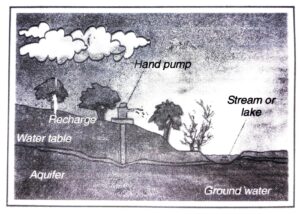SEBA Class 7 Science Chapter 7 Water: A Precious Resource – Textbook Solutions & MCQ (Part II)
Find Class 7 Science Chapter 7 “Water: A Precious Resource” Solutions for SEBA Assam (English Medium) students. This chapter, from Part II of the Science book, discusses the importance of water, its availability, sources, conservation methods, and the impact of water scarcity. Students will learn about the water cycle, groundwater depletion, and how human activities affect water resources. Our solutions include detailed textbook answers, multiple-choice questions (MCQs), and concept explanations to enhance understanding and help in exam preparation.
Class 7 Science
Chapter – 7 (Part II) Ospin Academy
Water: A Precious Resource
EXERCISE
Q. 1. Mark “T” if the statement is true and “F” if it is false:
(a) The fresh water stored in the ground is much more than that present in the rivers and lakes of the world. (TIF)
Ans: True.
(b) Water shortage is a problem faced only by people living in rural areas. (T/F)
Ans: False.
(c) Water from rivers is the only source for irrigation in the fields. (TIF)
Ans: False.
(d) Rain is the ultimate source of water. (T/F)
Ans: True.
Q. 2. Explain, how groundwater is recharged.
Ans: The ground water get recharged through the process of infiltration. Infiltration means seeping in water from rivers and lakes into the empty spaces and crack deep below the ground.
Q. 3. There are ten tube wells in a lane of fifty houses. What could be the long-term impact on the water table?
Ans: The effect on the water table depends on the replenishment of the underground water. As only five families will share a tube well, the water used for daily domestic purpose will not effect the water table as such. But if there is acute shortage of rains the water used by the families will not replenished and water table will fall down.
Q. 4. You have been asked to maintain a garden. How will you minimise the use of water?
Ans: To minimize the wastage of water, we will use the drip irrigation which throws the water at the base of plants. We will check the leakage in the water pipes and arrange small pits for rain water harvesting. The collected rainwater will be used later.
Q. 5. Explain the factors responsible for the depletion of water table.
Ans: Various factors are responsible for the depletion of water table:
(i) Increased Population: Increase in the human population has increased the demand for water. As the number of humans will keep on increasing, the consumption of water will also increase. Sources of water remain limited but consumption keeps on increasing causing great fall in water table.
(ii) Increasing industries: All industries need water. In increase in human population, the number of industries has also increased; so this has increased the consumption of water mainly from ground. This has caused depletion of ground water.
(iii) Agricultural activities: India is a country whose economy depends on the agriculture. With time the land used for cultivation has increased. Therefore, the consumption of water for agricultural purpose has increased. Rains are the main source of water for irrigation. But irregular rainfall has increased the dependence of farmers on the ground water. This has increased the depletion of ground water.
(iv) Lack of water conservation techniques: Main source of water on earth and for the underground water is the rain. The water of the rain, if conserved can increase the water level. But this is not done due to the lack of rain water harvesting techniques and other water conservation techniques.
Q. 6. Fill in the blanks with the appropriate answers:
(a) People obtain groundwater through _________ and _________.
Ans: Wells and hand pumps.
(b) Three forms of water are _________ , __________ and __________.
Ans: Solid, liquid and vapor.
(c) The water bearing layer of the earth is __________.
Ans: Aquifer.
(d) The process of water seepage into the ground is called ___________.
Ans: Infiltration.
Q. 7. Which one of the following is not responsible for water shortage?
(i) Rapid growth of industries.
(ii) Increasing population.
(iii) Heavy rainfall.
(iv) Mismanagement of water resources.
Ans: (iii) Heavy rainfall.
Q. 8. Choose the correct option. The total water:
(i) in the lakes and rivers of the world remains constant
(ii) under the ground remains constant.
(iii) in the seas and oceans of the world remains constant.
(iv) of the world remains constant.
Ans: (iii). In the seas and oceans of the world remains constant.
Q. 9. Make a sketch showing ground- water and water table. Label it.
Ans:

Q1: Why is water considered a precious resource?
Water is essential for life, but its availability is limited due to pollution, overuse, and climate change, making conservation crucial.
Q2: What are the main sources of fresh water on Earth?
The main sources of fresh water are rivers, lakes, glaciers, groundwater, and rainwater.
Q3: How does human activity contribute to water scarcity?
Overuse, deforestation, industrial pollution, and excessive groundwater extraction are key human activities leading to water scarcity.
Q4: Where can I find Class 7 Science Chapter 7 solutions for SEBA Assam?
You can find detailed textbook solutions, MCQs, and explanations for SEBA Assam Class 7 Science Chapter 7 (Part II) on this page.
Q5: Where can I find solutions for all Class 7 Science chapters?
To get solutions for all Class 7 Science chapters, Click Here

